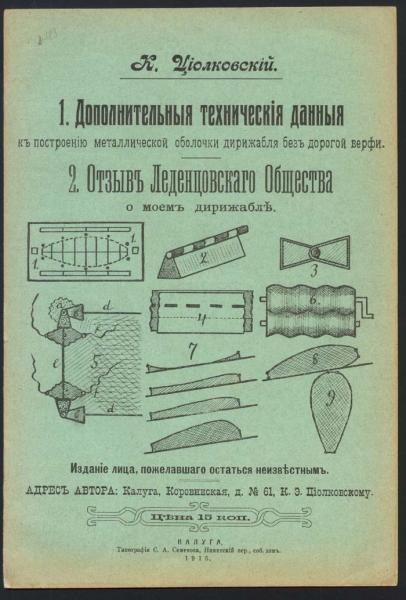|
TSIOLKOVSKI, TSIOLKOVSKIY, TSIOLKOWSKY, CIOLKOWSKY, ZIOLKOWSKY, TZIOLKOWSKY. 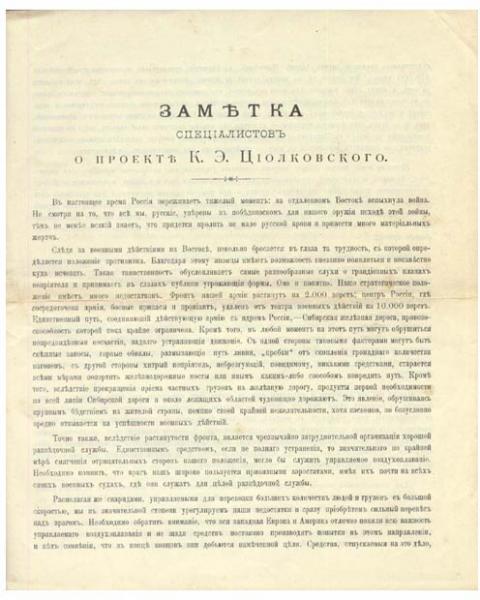 (Moskva, 10th of July, 1904). 4to. (26 x 21,5 cm). Unbound, in cloth box. 4 pp. (= pp. 1-4). Well preserved. Rare original article, printed before it was published in the newspapers and in periodicals, by fourteen engineers and scientists defending the inventions by Tsiolkovski. This article gives a very interesting and rare insight into the circumstances, under which T. was forced to publish his works and the rude lack of recognition he received. The article must be virtually impossible to get a hold of. Having examined all known attempts to construct a safe dirigible, and
realized taht none of them could work, T. came up with his own "breathing"
all-metal dirigible; he developed his idea fully and did not present it,
till everything was perfect. The idea was received with curiosity, but
the conclusion (by the Russian Technical Society) was that "the aerostat
(...) is doomed for ages, by the very nature of things, to remain a plaything
for the wind." (Collected Works, 1959, III: p. 6). None the less, T. continued
publishing his theories in a number of pamphlets and articles from 1892
- 1908. The response was varying, but in 1904 his proposals were discussed
in Kaluga by a group consisting of 14 engineers. "They concluded, among
other things, that his project was definately feasible, highly important
and indisputably correct from the theoretical standpoint. Following is
the text of a press report of these conclusions: "The author of this project,
as his numerous published works demonstrate, has rigorously and comprehensively
studied and elaborated the entire theory of aeronautics, carried out a
great deal of mathematical experimental research in this field, weighed
all the known principles of aeronautics, and in drafting his project, guided
himself only by incontestable principles established on the airship of
K.E. Tsiolkovskiy is the result of persistent toil and the zealous pursuit
of an idea. it is to be hoped that these remarks will not pass unnutoced
and that both the public and the press will remember the existence of this
project of our compatriot Tsiolkovskiy and support its materialization.
(Note: The conclusions of the group og engineers in Kaluga were published
separately on page 4 (Kaluga, 10 July 1904) and immediately afterward printed
in various Russian newspapers and periodicals). This is followed by the
signatures of 14 mechanical engineers, technologists, railroad engineers,
and candidates of mathematical sciences." (Collected Works, 1959, III:
p. 7-8). The article was still ineffective regarding official recognition
of his works, and at most provided the author with moral support.
Being the father of the all-metal dirigible aerostat with changeable volume and gas heating, his technical foresight was greatly in advance of the level of industrial development at the time. He came up with a number of entirely new ideas concerning dirigible design. He set out to develop a dirigible that would be safe as well as fast, up until then the dirigibles in use were neither. He wanted to ensure a longer flight-time, and was certain this could not be attained with the fabric envelopes in use at the time, -they leaked gas, lost hight and couldn't stay aloft for long at a time. Besides that they were insecure due to fire-hazard and not sufficiently strong. As the very first, T. developed the idea of an all-metal envelope that was capable of altering size, - the "breathing" metal envelope. "Tsiolkovskiy's ideas found no support either in Russia or abroad. His ideas were dozens of years ahead of the science and technology of his time. The subsequent development of the technology of dirigible construction shows that Tsiolkovskiy's ideas were adopted by many authors who, however, treated them as recent discoveries, without mentioning the name of Konstantin Eduardovich." (Collected Works, 1959, III: p. 11-12). "Forty years of experimenting were needed to produce concepts that had already been expressed by K.E. Tsiolkovkiy, while aeronautics was still in the cradle." (Collected Works, 1959, III: p. 17). With the invention of the all-metal dirigible T. has proved to be ahead of both contemporary scientists and inventors as well as of his time. "His work is now a shining beacon in science, attracting the attention of the scientists and designers called upon to provide mankind with a reliable transport dirigible." (Collected Works, 1959, III: p. 26). The father of modern rocketry, Konstantin Eduardovich Tsiolkovski (1857-1935), is probably most widely known for his works on rocket propulsion, however his contributions to several fields of science have been immense and of exceedingly seminal character. Deafened at the age of nine and as a consequence thereof unable to go to school, he was forced to learn everything on his own hand. His father, a forester, was fond of scientific experiments, and though not wealthy, he had books on science and natural history. Tsiolkovski began by reading all books he could find on these subjects and as a consequence was able to construct quite complicated devices for measuring distances and many other things. Having seen how gifted his son was, his father sent him to Moscow, where Tsiolkovski spend all three years in libraries, receiving no teaching but his own, but still succeeding in taking a degree in physics from the university. T. can thus be seen as a purely self-taught man. After Moscow he settled in the small city of Borovskoye, where he taught physics at a school, spending all his spare time conducting experiments and writing about them. He devoted his intellect mainly to three scientific problems of the greatest importance at the time: The aeroplane, the (long-range) rocket and the all metal dirigible. Self-taught as he was and unable to come in touch with new publications in his fields of interest, he began with nothing and made all necessary calculations himself. Calculations and experiments were always at the base of his scientific works, and no conclusions were derived from intuition and guesswork. He was the first in the world to solve numerous problems concerning his three main interests, but unable to be recognized by the tsar-regime and considered, at best, a dreamer and a utopian, the struggle for his inventions was long and hard. Aged 24 he was the first in the world to formulate the possibility of applying the principle of reactive motion for flight in a vacuum, thus presenting a simple plan for a spaceship. He established the possibility of space travel by means of rockets, and is thus called the father of rocketry. He is also called the father of the all-metal dirigible. He is the first to propose and state that liquid fuel is necessary for spaceflight. He was the first in the world to make calculations for the air-jet and turbo-prop-planes, and it is in his works we find the most complete elaboration of the theory of rocket propulsion for many years to come. "In his works on rocket dynamics Tsiolkovsky, the first in the history of science, calculated the efficiency of the rocket and pointed out the advantages of rocket motors at high velocities." (Kosmodemyansky, Moscow, 1956, p. 69). T. saw it as necessary step for mankind to explore and inhabit outer space and nothing could prevent him from working on the possibilities of this; in short, among many other things, we owe to him the fundamental principles of rocket dynamics. After the Revolution T. became a member of the Academy, was allotted a personal pension in 1921, and became able to devote himself entirely to his scientific work. Now his contemporaries finally saw him as the founder of a new domain of human knowledge, a new science, he was, and he was awarded the Red Banner of Labour Order for outstanding services to his country. |
|
TSIOLKOVSKI, TSIOLKOVSKIY, TSIOLKOWSKY, CIOLKOWSKY, ZIOLKOWSKY, TZIOLKOWSKY.
1. Dopolnitjenyja tjekhizsjeskija dannija k postrojeniju metallizsjeskoj obolozski dirischablja bjez dorogoj verfi. 2. Otzyv Ljeljenpovskago Obschtstva o mojem dirischabl. Izdanije litsa, poschjelavschtsago ostatcja njeizvctnym (Russian). (1. Additional Technical Data on the Construction of Metal Envelope of Dirigible Without Expensive Dock. 2. The Attitude of the Ledentsovskiy Society towards My Dirigible. Published by a Person, who Wishes to Remain Unknown). Kaluga, 1915. 8vo. (25,5 x 17 cm). Orig. printed, illustrated green wrappers, inside af wrappers also illustrated w. figures. Faint fading at edges, otherwise mint condition. Illustr. 10 pp. (= pp. 1-10). Exceedingly rare and important first edition (in Russian).
|
|
TSIOLKOVSKI, TSIOLKOVSKIY, TSIOLKOWSKY, CIOLKOWSKY, ZIOLKOWSKY, TZIOLKOWSKY. 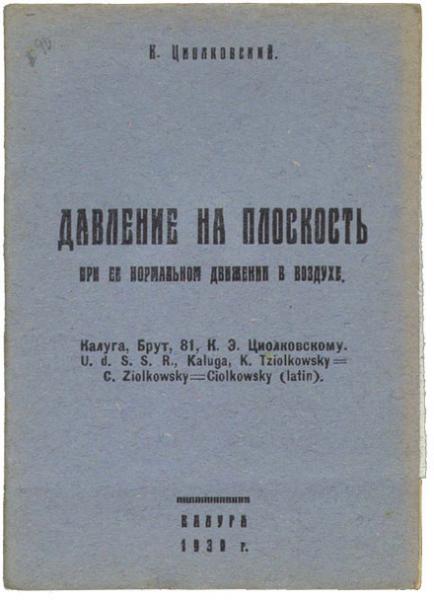 Davljenije na ploskost pri jeje normalnom dvischjekii v vozdukhje (Russian). (The Preassure on a Plane in Normal Motion in Air). Kaluga, 1930. (12mo 14,5 x 10 cm). Orig. printed blue wrappers. Very well preserved. 49 pp. (= pp. 1-49). First edition. All works by Tsiolkovsky are rare and important.
|
|
TSIOLKOVSKI, TSIOLKOVSKIY, TSIOLKOWSKY, CIOLKOWSKY, ZIOLKOWSKY, TZIOLKOWSKY. 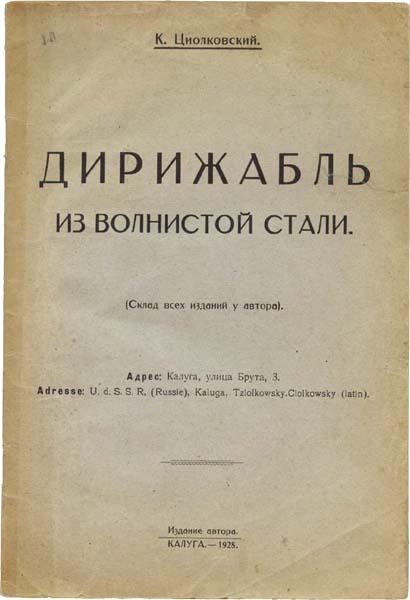 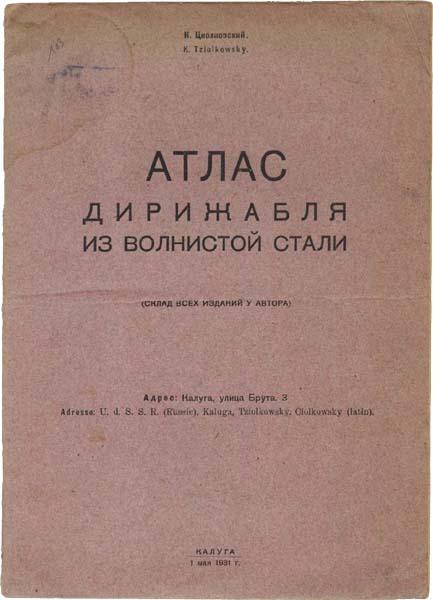 Kaluga, 1928 + 1930. Both 8vo. (26 x 17,5 cm. + 25 x 17,5 cm). Both in the orig. printed wrappers. Minor soiling to front-wrappers, but both works are well preserved. The first wok contains 4 pp. and the Atlas 15 pp. almost entirely with illustrations. 17 pp. (= pp. 1-17) + 24 pp (= pp. 1-24). Two very rare and important, ricly illustrated first editions (in Russian).
|
|
TSIOLKOVSKI, TSIOLKOVSKIY, TSIOLKOWSKY, CIOLKOWSKY, ZIOLKOWSKY, TZIOLKOWSKY. 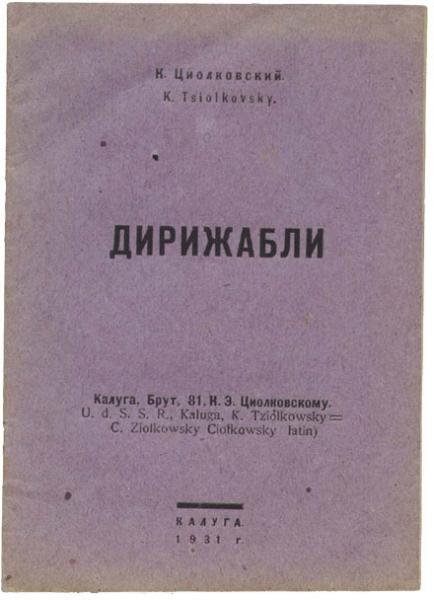 Kaluga, 1931. Small 8vo. (15,5 x 11 cm). Orig. purple printed wrappers. A few small holes to the last leaves, not affecting text, otherwise very well preserved. 32 pp. (= pp. 1-32). Rare first edition (in Russian).
|
|
TSIOLKOVSKI, TSIOLKOVSKIY, TSIOLKOWSKY, CIOLKOWSKY, ZIOLKOWSKY, TZIOLKOWSKY. 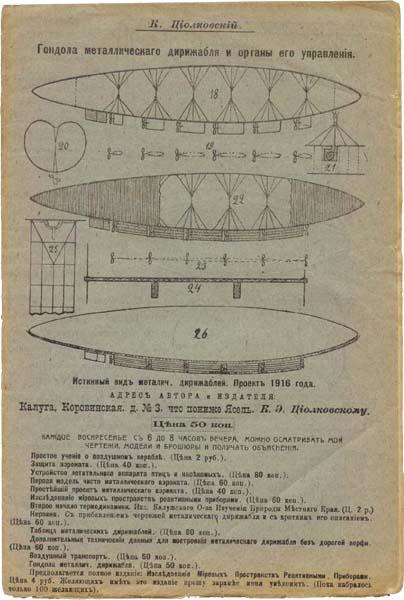 Gondola metallizsjeskago dirischablija i organy ego uprabljenija (Russian). (The Gondols of the Matal Dirigible and its Controls." Kaluga, (1918). 8vo (26,8 x 18 cm). Orig. printed illustrated wrappers, inside of wrappers also illustrated w. figures. One text-illustration. Uncut and unopened. A few tears to extremities and some fading. 24 pp. (= pp. 1-24). Exceedingly rare and interesting first edition (in Russian). Early and elaborate description of Tsiolkovski's famous, huge transport dirigible. He is the inventor of the all-metal dirigible, which, in contrast to all other dirigibles at the time, would not be inflammable and which would be albe to keep the gas inside it; he found it possible to heat the hydrogen artificially, thus providing the dirigible with constant and perfect vertical maneuverability. No other dirigibles than his could be controlled by man. As T. in 1919 became a member of the Socialist Academy (later cooperated in the USSR Academy of Science), recognition and money enabled him to publish a much larger quantity of articles and books than he had done before. Everything by T. published before 1918 was paid for by himself; his modest salary only allowed him to pay for few copies of each, and four times as many of his articles, booklets and books were published after 1918 as in all the years before; each one after 1918 was likewise issued in a much greater number. "During a period of 26 years before the revolution his publications numbered less than 50." (Collected Works, NASA, 1951, I; p. X). This together with the fact that his work was not recognized and his experiments discredited, means that probably very few copies were preserved. His early works are thus of the greatest rarity. "Like all the pre-1918 papers by Tsiolkovsky, which were printed on his own expense in very small numbers only, that virtually have disappeared and the re-occurrence of one of them …is very remarkable." (Catalogue 282, Interlibrum Vaduz). |
|
TSIOLKOVSKI, TSIOLKOVSKIY, TSIOLKOWSKY, CIOLKOWSKY, ZIOLKOWSKY, TZIOLKOWSKY. 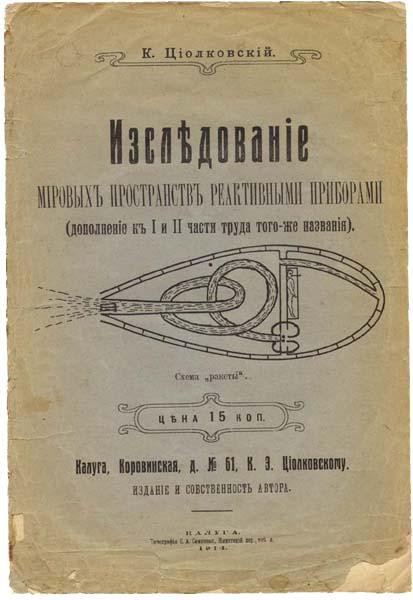 Kaluga, 1914. 8vo. (25,8 x 17,5 cm). Original printed, illustrated wrappers. Some tears to wrappers, but most of it intact, only lacking parts of corners. Internally some tears to edges and corners, but none affecting text or illustration. Illustrated w. one figure ("Skhema "pakjety" - a cutthrough of the rocket). Exceedingly rare and important first edition (in Russian). As T. in 1919 became a member of the Socialist Academy (later cooperated in the USSR Academy of Science), recognition and money enabled him to publish a much larger quantity of articles and books than he had done before. Everything by T. published before 1918 was paid for by himself; his modest salary only allowed him to pay for few copies of each, and four times as many of his articles, booklets and books were published after 1918 as in all the years before; each one after 1918 was likewise issued in a much greater number. "During a period of 26 years before the revolution his publications numbered less than 50." (Collected Works, NASA, 1951, I; p. X). This together with the fact that his work was not recognized and his experiments discredited, means that probably very few copies were preserved. His early works are thus of the greatest rarity. "Like all the pre-1918 papers by Tsiolkovsky, which were printed on his own expense in very small numbers only, that virtually have disappeared and the re-occurrence of one of them is very remarkable." (Catalogue 282, Interlibrum Vaduz). This is one of Tsiolkovski's most important works. It is written at a time when the lack of recognition together with the realization that his discoveries were of groundbreaking character became almost too much for him. He begins the article by writing "It is difficult to work alone and in adverse circumstances for many years without receiving recognition or encouragement from anyone. From the articles concerning "rockets" it is clear that with our present technology we are still far from attaining the required velocities. Now, however, I would like to popularize my ideas, to offer explanations, and refute the view that the "rocket" is something far beyond our grasp. Below are some of the theorems I have already proved; here I shall dwell on those that may seem not entirely convincing." The front-wrapper shows a section through his rocket, also with an astronaut. "From 1903 to 1917 Tsiolkovsky offered several plans for constructing
rocket ships. He considered such questions as guiding a rocket in vacuum,
the use of a fuel component to cool the combustion chamber walls, and the
application of refractory elements." (D.S.B. XIII:483).
"Today, his original research, in the course of which he not only predicted the development of jet aircraft and low-range rockets but theoretically confirmed their feasibility, is necessarily of great interest to the entire aerospace community. He was the founder of the science astronautics (cosmonautics), which is concerned with the problems of interplanetary travel, and he derived the classical formulas of rocket flight." (Collected Works, NASA, 1951. I: p. IX). |
|
TSIOLKOVSKI, TSIOLKOVSKIY, TSIOLKOWSKY, CIOLKOWSKY, ZIOLKOWSKY, TZIOLKOWSKY. 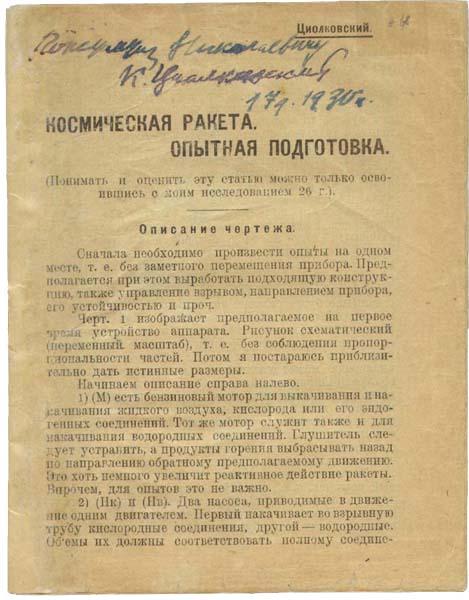 (Kaluga, 1927). 8vo. (17 x 13 cm). No wrappers (none issued). One full-page illustr. of a rocket-motor. First two and last two leaves w. repairs to margins, otherwise fine. 24 pp. (= pp. 1-21). Very rare and important work, published by the author himself. With
original handwritten dedication in Russian for R(...?) "Nikolajevskij/
K. Tsiolkovskij/ 17 9. 1939 g." The work was issued without title-page
and wrappers.
|
|
TSIOLKOVSKI, TSIOLKOVSKIY, TSIOLKOWSKY, CIOLKOWSKY, ZIOLKOWSKY, TZIOLKOWSKY.  Kaluga, 1929. 8vo. (21,5 x 15 cm). Original printed wrappers. Front-wrapper lacking small part of upper right corner, a few tears to extremities, otherwise fine. 38 pp. (=pp. 1-38) + a portrait of Tsiolkovski. Rare and important first edition (in Russian).
|
|
TSIOLKOVSKI, TSIOLKOVSKIY, TSIOLKOWSKY, CIOLKOWSKY, ZIOLKOWSKY, TZIOLKOWSKY.  Kaluga, 1929. 8vo (17 x 12,5 cm). Orig. printed red wrappers. Minor dampstaining to upper corner of wrappers, not affecting text. Otherwise very well preserved. 38 pp. (= pp. 1-38) + 1 leaf w. illustrations. Rare first edition (in Russian). Printed privately by the author. One
of his most important works on rocket dynamics and interplanetary flight.
|
|
TSIOLKOVSKI, TSIOLKOVSKIY, TSIOLKOWSKY, CIOLKOWSKY, ZIOLKOWSKY, TZIOLKOWSKY.  Kaluga 1930. Orig. printed wrappers. 8vo. (16,5 x 12,8 cm). A few spots to margins of wrappers, otherwise mint. 91 pp. + 21 pp. with illustrations only. Rare and interesting first edition (in Russian). Few of T.'s works are as extensive and elaborate as this one. T. was clearly very much ahead of his time in the design of the metal dirigible presented here. Science and technology only very lately grasped his conceps and by the time they did, their author was forgotten and T.'s name was, very wrongly, not mentioned. "The works of Tsiolkovskiy that date from the Soviet period repeat the principle assumption of his theory of the metal aerostat, provide counsel on the practical organization of experimental work, survey critically the existing types of dirigibles, and point out the errors in the research into metal-envelope dirigibles in the USSR and abroad." (Collected Works, 1959, III: p. 23). |
|
TSIOLKOVSKI, TSIOLKOVSKIY, TSIOLKOWSKY, CIOLKOWSKY, ZIOLKOWSKY, TZIOLKOWSKY. 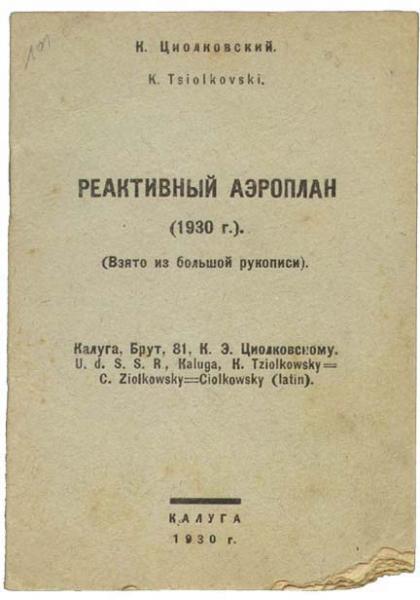 Kaluga, 1930. Small 8vo (14,5 x 10 cm). Orig. printed wrappers, Lower right corner missing throughout, not affecting text. Otherwise very well preserved. 24 pp. (= pp. 1-24). Rare and important first edition (in Russian). Tsiolkovski spent the
last years of his life developing the theory of jet aircraft.
|
|
TSIOLKOVSKI, TSIOLKOVSKIY, TSIOLKOWSKY, CIOLKOWSKY, ZIOLKOWSKY, TZIOLKOWSKY. 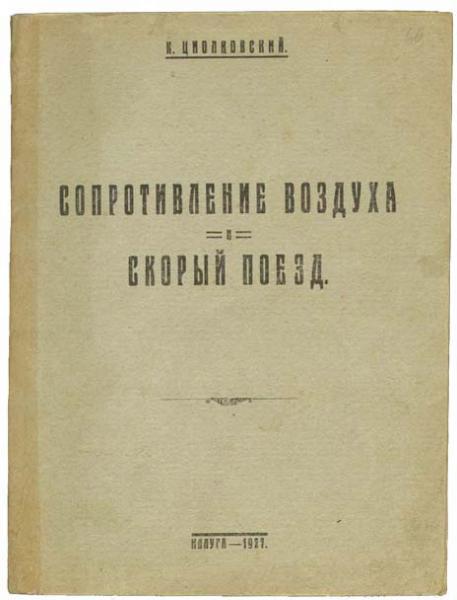 Kaluga, 1927. Small 8vo (17 x 12,5 cm.) Orig. wrappers, back professionally repaired. Very well preserved. Illustr. w. three figures. 72 pp. (= pp. 1-72). First edition. All works by Tsiolkovski are rare and important.
|
|
TSIOLKOVSKI, TSIOLKOVSKIY, TSIOLKOWSKY, CIOLKOWSKY, ZIOLKOWSKY, TZIOLKOWSKY.  Kaluga, 1932. Small 8vo (14,3 x 10,5 cm). Orig. printed wrappers, illustrated w. four figures on inside of wrappers. Very well preserved. W. stamp (3 kop.), poststamp (from Kaluga) and address written in hand (probably Tsiolkovski's own) on back-wrapper. 32pp (=pp. 1-32). Rare and important first edition (in Russian). During the 1920's he elaborated his theories of multistage-rockets and began working out his theory of the flight of jet airplanes, devoting a number of papers to this. It is in this work (and in "The Rocketplane") he developes the theory of the liquid-fuel jet engine in an aeroplane and for the first time in technical literature describes the turbo-prop aircraft, -and in great detail. "... This is an indispensible contribution of Russian science to the common treasury of human culture." (Collected Works, NASA, 1954, II: p.17). |
|
TSIOLKOVSKI, TSIOLKOVSKIY, TSIOLKOWSKY, CIOLKOWSKY, ZIOLKOWSKY, TZIOLKOWSKY. 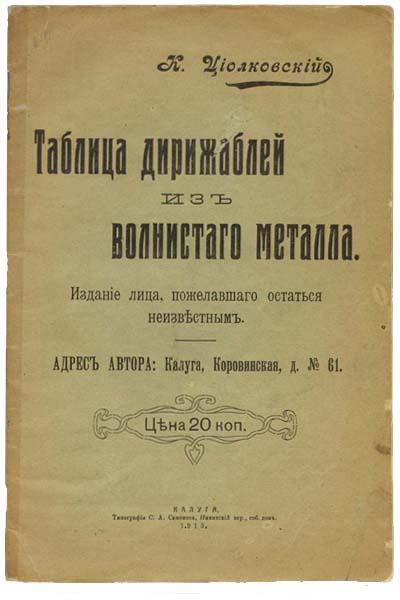 Kaluga, 1915. 8vo. (25,5 x 17 cm). Orig. printed wrappers, illustrated w. figures on the inside. Back repaired. Small nicks and scratches to extremities. Tear to front wrapper professionally restored. In good condition. 22pp (=pp. 1-22). Exceedingly rare and important first edition (in Russian).
|
|
TSIOLKOVSKI, TSIOLKOVSKIY, TSIOLKOWSKY, CIOLKOWSKY, ZIOLKOWSKY, TZIOLKOWSKY. 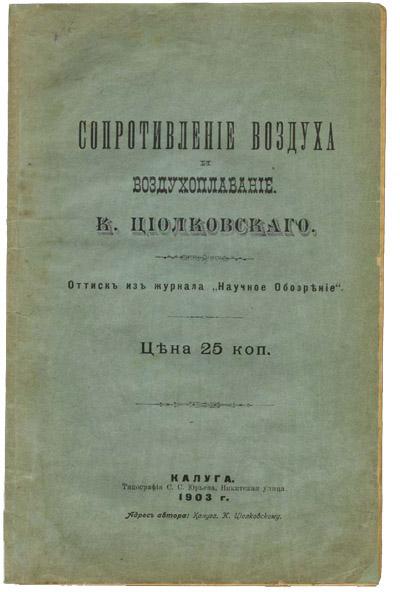 Soprotivljenije vozdukha i vozdykhoplavanije. Ottisk iz schurnala "Hayzsnoje Obozrenije" (Russian). (Air Resistance and Aeronautics [or Air Resistance and Flight in Air]. Offprint from the Magazine "Scientific Review"). Kaluga, 1902 (colophon stating 1902, wrapper stating 1903). 8vo (23,5 x 15 cm). Uncut in the orig. printed blue-green wrappers. Professionally resored at corners. Internally brownspotted. Well-preserved copy. 22 pp. (= pp. 1-22). Exceedingly rare first edition (in Russian). It was printed as an article in "Scientific Review" and an offprint was made, no other issues appeared, thus these wrappers must be the original, even though they state 1903 and the colophon 1902. As it was printed at Tsiolkovski's own expenses and he did not have much money, it is likely that he had the wrappers for the offprint printed the following year. A work of great rarity; all his subsequent works on this topic (aerodynamics) belong to the Soviet period. Tsiolkovski created one of the world's first wind-tunnels ("vaned blower"). "In 1897 he constructed a wind tunnel, the first in Russia to be used in aviation." (D.S.B. XIII: 483). He experimented with it every day for more than four years. From these experiments he "was able to determine with remarkable accuracy such a small quantity as, for example, the air friction on the surface of a model and to establish the fundamental laws by which it is governed." (Collected Works, 1951, I: pp. 8-9). Having the modest salary of a teacher, these experiments cost him most of his money, and he tried to raise money for his experiment through the Russian Academy of Sciences. The examiner of the project, M.A. Rykachev, found it very interesting and of great importance, and for the fist time Tsiolkovski was granted money to continue his experiments (470 rubles); he spent all the money on building an even larger wind-tunnel. The results of these seminal experiments were published for the first time in this exceedingly rare article from 1902. To his disappointment he was granted no more funds and as suspicion from the other scientists and the tsar-regime rose towards him, the fundamental results attained in this work remained unacknowledged by the official scientific circles. As Tsiolkovski in 1919 became a member of the Socialist Academy (later cooperated in the USSR Academy of Science), recognition and money enabled him to publish a much larger quantity of articles and books than he had done before. Everything by T. published before 1918 was paid for by himself; his modest salary only allowed him to pay for few copies of each work, and four times as many of his articles, booklets and books were published after 1918 as in all the years before; each one after 1918 was likewise issued in a much greater number. "During a period of 26 years before the revolution his publications numbered less than 50." (Collected Works, NASA, 1951, I; p. X). This together with the fact that his work was not recognized and his experiments discredited means that probably very few copies were preserved. His early works are thus of the greatest rarity. "Like all the pre-1918 papers by Tsiolkovsky, which were printed on his own expense in very small numbers only, that virtually have disappeared and the re-occurrence of one of them …is very remarkable." (Catalogue 282, Interlibrum Vaduz). Tsiolkovski was a pioneer in the field of experimental aerodynamics; by, among other things, building one of the world's first wind-tunnels, he derived a number of highly important laws of aerodynamics. There is no doubt that T. is one of the founders of modern aerodynamics. SOURCE and CREDIT: LYNGE
RARE BOOKS DENMARK
|
